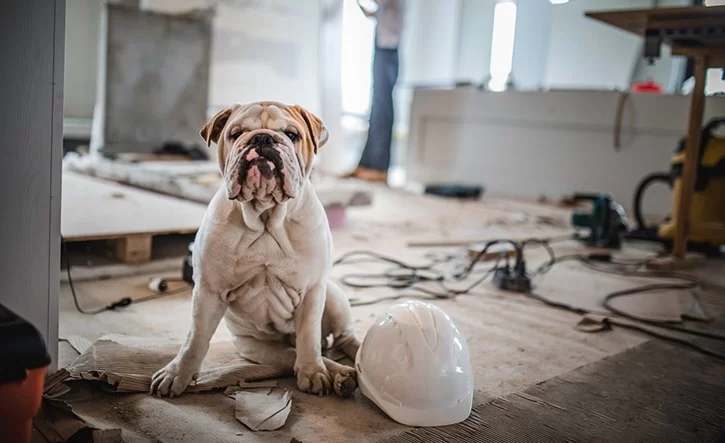- how-to-recognize-pet-stress-signs-during-renovations
- creating-a-safe-zone-before-construction-begins
- daily-management-tactics-to-keep-pets-calm
- real-stories-from-pet-owners-and-what-we-can-learn
- long-term-behavior-considerations-during-remodeling
- how-hidden-brook-veterinary-supports-your-pets-wellbeing
1. How to Recognize Pet Stress Signs During Renovations
Home renovations bring noise, dust, and strangers into your pet’s safe territory—and that can trigger stress in even the calmest animals. Dogs may bark excessively, pace, or show clingy behavior, while cats may hide for long periods or refuse to eat. These reactions aren’t misbehavior; they are instinctive responses to disruption and unfamiliar sounds.
Understanding these early signs helps you take action before stress escalates into health problems or destructive behavior. Many pet owners report that their animals become unsettled as soon as contractors begin unloading equipment. Pets read environmental changes quickly, so recognizing the first signs of anxiety is the first step toward creating a stable environment.
2. Creating a Safe Zone Before Construction Begins
2.1 Choose the Right Space
Before the first hammer swings, select a quiet room far from the renovation area. This space should include your pet’s bed, toys, water, and comforting scents. Consistency is key—the room becomes a sanctuary they can rely on when the rest of the home feels unpredictable.
2.2 Use Familiar Items to Build Security
A blanket that smells like you, a favorite chew toy, or a scratching post can reassure pets that this space still belongs to them. Many cats respond positively to elevated hiding spots, while dogs appreciate cozy bedding tucked into a corner where they can “den up.”
2.3 Consider Sound Management
Construction noise is one of the biggest stress triggers. Adding soft background music, white noise, or a quiet fan helps mask unpredictable loud sounds. This small adjustment can drastically reduce anxiety throughout the day.
3. Daily Management Tactics to Keep Pets Calm
3.1 Maintain Routines Whenever Possible
Pets rely heavily on predictable patterns. Feeding at the usual time, keeping walks consistent, and maintaining play sessions gives them emotional stability even when surroundings feel chaotic. A dog who gets his morning walk won’t panic as easily when construction noise starts later.
3.2 Introduce Contractors Gradually
If your pet will occasionally encounter workers, start with a brief, controlled introduction. A calm hello from across the room can help your pet understand the new people aren’t threats. Avoid allowing contractors to pet or interact too closely—this can overstimulate anxious pets.
3.3 Limit Visual Triggers
Seeing unfamiliar people and movement increases stress. Using baby gates or opaque barriers can help pets relax without feeling forced to monitor every activity happening in the home.
4. Real Stories from Pet Owners and What We Can Learn
During a major kitchen remodel in Texas, one pet owner found her usually confident Labrador suddenly refusing to enter the living room. The constant drilling made him tremble. After designating a quiet bedroom as his safe zone and adding soft music, his anxiety improved dramatically within days.
Another case involved a family with an indoor cat in New Jersey. When workers opened entry doors frequently, the cat attempted to bolt outside—something she had never done before. The family learned to move her litter box and essentials into a closed, upstairs room until renovations finished. This prevented escape risks and kept her stress levels manageable.
These examples demonstrate the importance of observation and flexible planning. Every pet reacts differently, but most need predictability, reduced stimuli, and reassurance.
5. Long-Term Behavior Considerations During Remodeling
5.1 Watch for Behavioral Regression
Stress can make pets revert to old habits—accidents, barking, scratching furniture, or hiding. These behaviors aren’t permanent. With patience and consistent comfort, most pets naturally return to normal once construction ends.
5.2 Introduce Finished Spaces Slowly
When the renovation is complete, allow your pet to explore the new space at their own pace. Some animals may be wary of new textures, smells, or arrangements. Encourage exploration with treats or gentle praise to rebuild confidence.
5.3 Seek Professional Guidance When Necessary
If anxiety persists or worsens, professional support can make a significant difference. Veterinary behaviorists and experienced clinics help determine whether supplements, calming products, or behavior plans are appropriate.
6. How Hidden Brook Veterinary Supports Your Pet’s Wellbeing
Hidden Brook Veterinary provides expert guidance for families navigating home renovations with pets. Their team assists with personalized stress-reduction plans, behavior assessments, and recommendations tailored to your pet’s personality and needs. Whether you're managing mild anxiety or complex behavioral shifts, Hidden Brook Veterinary offers trusted support to keep your pets comfortable and secure.
Renovations are temporary, but your pet’s wellbeing is long-term. With the right strategies—and professional help when needed—you can create a peaceful environment that protects your pet from unnecessary stress during home upgrades.












